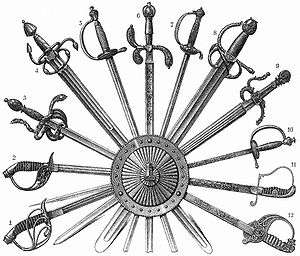Caladbolg
Caladbolg ("hard cleft", cognate with Middle Welsh: Caledfwlch in medieval Welsh literature and Excalibur in the Matter of Britain; the name appears in the plural as a generic word for "great swords" in the 10th-century Irish translation of the classical tale The Destruction of Troy, Togail Troí[1][2]), sometimes written Caladcholg ("hard blade"), is the sword of Fergus mac Róich from the Ulster Cycle of Irish mythology. Spelled Caladcholg, it is also associated with the more obscure Ulster hero Fergus mac Léti, suggesting a conflation of two legends. It was said to be a two-handed sword that made a circle like an arc of rainbow when swung, and to have the power to slice the tops off hills and slaughter an entire army.
During the events of the Táin Bó Cúailnge, Ailill mac Máta takes Caladbolg away from Fergus mac Róich when he discovers Fergus' affair with his wife Medb. He gives it back when the Ulaid rally against his armies. Fergus wreaks havoc against Ulster's forces with his blade, but Conall Cernach convinces him not to kill Conchobar mac Nessa. Fergus strikes the "Three Great" Strokes on three small hills instead, blasting off their tops.
